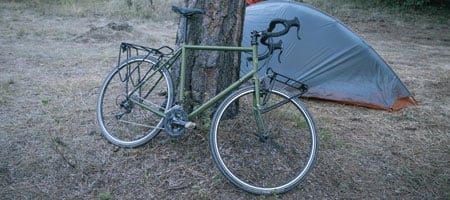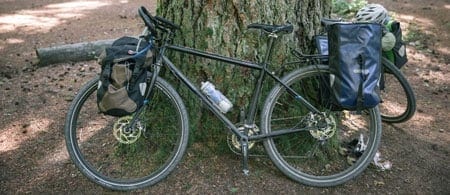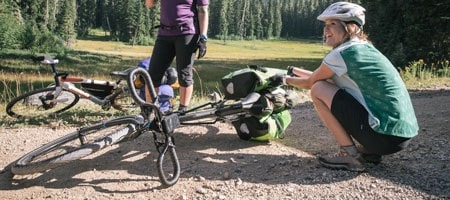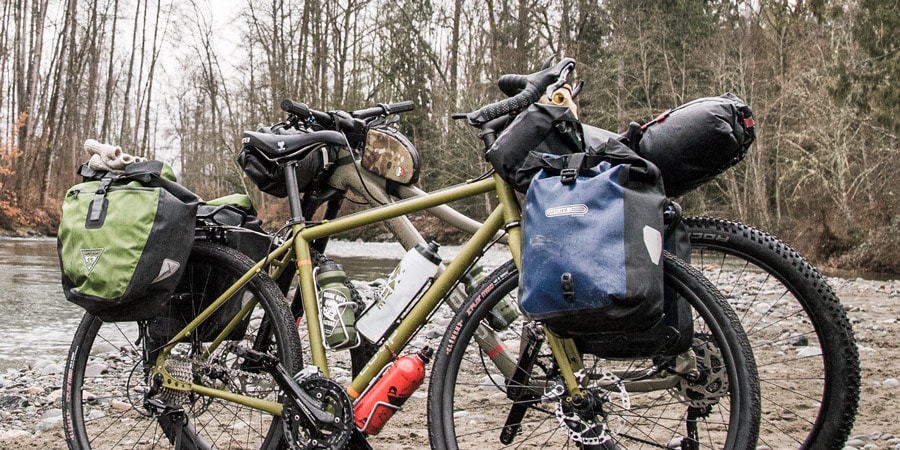Whether you use your bike to commute, run errands or take longer trips, you'll need a way to carry essentials, from a small repair kit to full-on camping gear. A daypack or messenger bag is good for shorter trips, but some of your best gear-carrying options are racks, baskets and bags that fit on your bike.
Video: How to Choose Bikes Bags & Racks
Types of Bike Racks

Rear Rack
A rack provides a stable framework to hold gear on your bicycle. In good weather, items can be strapped directly to the rack without a cover. For foul weather or the ability to hold loose items together, bags such as rack trunks and panniers can be easily attached to the rear rack.
Rear racks are usually rated to carry loads between 20 and 50 pounds, which is sufficient for most uses. A few heavy-duty touring models are able to carry up to 80 pounds. These racks typically have three supports per side (others have only two).
Rear racks are designed to attach to the braze-on mounts that many bikes have. If your bike does not have braze-on mounts, you can still mount a rack using metal C clips included with the mounting hardware of most racks. These clips wrap around your bike's frame tubes and accept the lower mounting bolt.
Front Rack
A front rack offers an additional mounting spot for gear. It is a secondary option after a rear rack as it adds weight to the bike's front wheel and can affect steering and balance. Front racks are popular mostly with touring cyclists who carry large volumes of gear.
There are two primary styles of front racks:
A standard rack (also called a "top mount") maximizes gear capacity as the load can be carried above the front wheel as well as hung off the sides.
A low rider rack accepts bags only on the sides but holds that weight closer to the ground for better balance.
As with rear racks, front racks are designed to attach to the braze-on mounts on your bike.
Bike Trailer for Cargo
If you have lots of gear to haul, consider a bike trailer for cargo. A trailer gives you lots of storage space for carrying heavy loads in town or on long-distance tours.
Cargo trailers typically attach to the rear hub of your bike. A trailer can be used on its own or with front and rear racks, depending on how much you need to carry. Some riders prefer the feel of having the weight off of the bike frame and therefore choose to pull a trailer rather than carry everything on front and rear racks.
Types of Bike Bags

Panniers
Best for carrying everyday essentials, extra clothes and camping gear on bike commutes, urban rides and long-distance tours.
Named after the French word for baskets, panniers offer roomy storage, protection from weather and the ability to quickly disconnect from a rack on your bike so you can take your gear with you. They attach to racks using a simple system of spring-loaded hooks, clips or bungee cords. They can be used singly or in pairs, and are designed specifically for front or rear racks.
Small items tend to get lost in large panniers, so consider using stuff sacks to get organized.
Caution: Make sure your heel does not contact the bag during your normal pedaling rotation. Too-large panniers (or those improperly mounted too far forward) can cause this impact and an unsafe riding situation.
Baskets
Best for carrying a range of items, including grocery bags, on fair-weather rides.
Baskets can carry loads on the front and/or back of your bicycle. Rear baskets are usually mounted on either side of the rear wheel. They can carry tall loads, as they have no lid.
Front baskets tend to be smaller than their rear-mounted cousins; they are most often hung off the handlebars or anchored to the front fork with metal stays.
Saddle Packs
Best for carrying small items like a multi-tool, spare tube, tire levers, a patch kit or an energy bar.
Also called a seat bag, saddle bag or underseat bag, this fits under your bicycle seat and usually attaches to the rails of the saddle itself. Larger models can carry a few extra items. Keep this mounted to your bike to ensure you never leave home without the essentials.
Handlebar Packs
Best for carrying frequently used items, such as a camera, sunscreen and snacks.
This attaches to your handlebars with clamps or straps. It offers easier access and often more room than a seat bag. Some models feature a clear plastic sleeve on top to display a map—a popular choice among touring cyclists.
Caution: Be sure the bag you choose does not affect your ability to operate the brakes or shifters on your bike, and do not overload it as extra weight carried up this high can affect balance.
Rack Trunk
Best for carrying a jacket, tools and food when you need a bag smaller than a pannier, but larger than a seat bag.
Rack trunks are smaller than panniers but larger than seat bags, making them a happy medium for carrying extra clothing, bike tools and lunch. Many have plastic sheets to reinforce the base area and retain the shape of the bag. Packing is simplified by some sort of pocket system or divided storage. Some trunks even offer integrated raincovers.
Frame Bags
Best for storing food, phones and tools within easy reach.
Most frame bags attach to the top tube of your bike and are sized to keep food, phones, tools and other essentials within easy reach. Larger frame bags for bikepacking and touring can hold hydration reservoirs.
Bike Bag Features

Adjustability
Some bags adjust via compression straps or expandable collars. This allows you to carry loads of varying sizes without having the unused portion of the bags flapping in the wind or the load shifting as you move on your bike.
Ease of Access
Handlebar bags are more accessible than panniers or seat bags, making them a great choice for small, frequently used items. Other characteristics to consider: How many openings are there? Zippers or flaps? Are there small pockets for organization or simply a large, undivided space?
Water Resistance
If you're an all-conditions rider who doesn't shy away from rain and road spray, look for a bag rated as "waterproof" instead of "water resistant." Waterproof bags are made from a rubberized material to keep the contents dry even in a downpour. Many feature a roll-top closure to prevent water from getting in.
Attachment Options
If you park in public areas, you'll probably want to take your gear with you. Panniers attach to racks using a simple system of spring-loaded hooks, clips or bungee cords and are easy to disconnect. For seat bags, look for one with a quick-release mounting bracket rather than a set of buckles or rip-and-stick straps.

Caution: Be sure that your bags attach securely to your bicycle. Loads that are not secured can shift during your ride unexpectedly and cause a loss of control.
